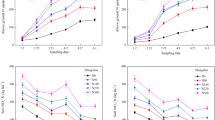Summary
Distribution patterns of nitrate in field are studied in twelve treatments comprising of different N splits and irrigation schedules, after the harvest of wheat. Total amount of irrigation and nitrogen application were kept same for each treatment. The curves show that heavy irrigation at greater intervals can result in larger amount of unutilised NO3 −-N, which will eventually be lost beyond potential rooting zone. As irrigation becomes lighter and frequent, nitrates travel slowly and thus remain for more time within the reach of roots and are lost to a less extent. When whole of the nitrogen is applied in one lot, considerably more NO3 −-N is lost under all the irrigation schedules. As the number of splits are increased, susceptibility of nitrate nitrogen for leaching decreases to a greater extent under lighter and more frequent irrigation schedule than the other. Besides N-splitting and irrigation criteria, efficiency and depth of rooting system of plants seems to play a major role in defining nitrate leaching patterns towards unsaturated zone.
Similar content being viewed by others
References
Adriano D. C., Pratt P. F. and Takatori F. H., Nitrate in unsaturated zone of an alluvial soil in relation to fertilizer nitrogen rate and irrigation level. J. Environmental Quality 1, 418–422 (1972).
Bates T. E. and Tisdale S. L., The movement of nitrate nitrogen through columns of coarse textured soil materials. Soil Sci. Soc. Am. Proc. 21, 525–528 (1957).
Boswell F. C. and Anderson O. E., Nitrogen movement comparisons in cropped versus fallowed soils. Agron. J. 62, 499–503 (1970).
Boswell F. C. and Anderson O. E., Nitrogen movement in undisturbed profiles of fallowed soils. Agron. J. 56, 278–281 (1964).
Bremner J. M., Inorganic forms of nitrogen. in Methods of Soil Analysis 2, ed. C. A. Black et al., Agronomy 9, 1179–1237. Am. Soc. Agron., Inc. Madison, Wisc. (1965).
Burns G. R. and Dean L. A., The movement of water and nitrate around bands of sodium nitrate in soils and glass beads. Soil Sci. Soc. Am. Proc. 28, 470–474 (1964).
Pratt P. F., Jones W. W. and Hunsaker V. E., Nitrate in deep soil profiles in relation to fertilizer rates and leaching volume. J. Environmental Quality 1, 97–102 (1972).
Warrick A. W., Biggar J. W. and Nielsen D. R., Simultaneous solute and water transfer for an unsaturated soil. Water Resources Research 7, 1216–1225 (1971).
Wetselaar R., Nitrate distribution in tropical soils I. Possible causes of nitrate accumulation near the surface after a long dry period. II. Extent of capillary accumulation of nitrate during a long dry period. Plant and Soil 15, 110–120, 121–133 (1961).
Author information
Authors and Affiliations
Rights and permissions
About this article
Cite this article
Singh, B., Sekhon, G.S. Some measures of reducing leaching loss of nitrates beyond potential rooting zone. Plant Soil 44, 193–200 (1976). https://doi.org/10.1007/BF00016966
Received:
Published:
Issue Date:
DOI: https://doi.org/10.1007/BF00016966




